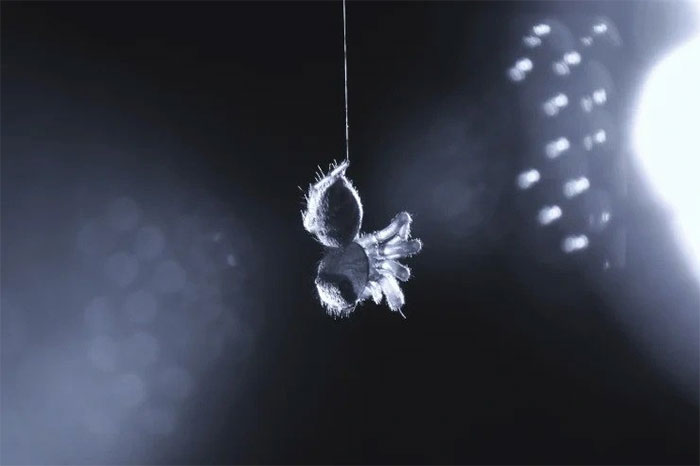New research reveals the mystery of jumping spiders' dreams
After a day of stalking and pouncing, jumping spiders of the species Evarcha arcuata probably dream when night falls.
When this jumping spider is twitching its legs and moving its eyes, it means they are in REM (rapid eye movement) sleep, reports the journal Proceedings of the National Academy of Sciences.
REM is a common sleep state in humans, but new research has shown that REM sleep may be more common in animals than previously thought. This could help unravel the mystery of REM's purpose and evolution in animals.
Lauren Sumner-Rooney, a sensory biologist at the Leibniz Institute for Biodiversity and Evolution (Germany), commented: 'Discovering REM sleep from an animal as far away from humans as a spider is very exciting. taste".
Daniela Roessler, a behavioral ecologist at the University of Konstanz in Germany, and one of the authors of the study, found that sometimes jumping spiders hang upside down at night.
Dr. Roessler recorded the spider resting and noticed the strange behavior. "Suddenly they move their legs wildly and twitch. It reminds me of a sleeping dog or cat," she said.

A jumping spider twitching its legs in a state that resembles REM sleep
Such jerky movements of the extremities are a sign of REM sleep, a state in which most muscles stop working while the brain signals to be awake and the eyes are constantly moving. This state is difficult to detect in animals, especially those with non-moving eyes like spiders.
However, part of the jumping spider's eye still has movement. This spider has a total of 8 eyes and behind the lens layer of the two largest eyes is a layer of light-capturing retina capable of moving to scan its surroundings.
Jumping spiders' bodies usually obscure the above banana-shaped retina, unless they are still young spiders with a transparent exoskeleton. So, Dr. Roessler's team watched the retinas move back and forth in baby spiders less than 10 days old when they were resting.
The researchers recorded the spiders with an infrared camera at night. In 34 animals, they saw episodes of retinal and limb movements that coincided, usually lasting about 80 seconds and occurring every 15 to 20 minutes. They recorded the behavior of jumping spiders, from spinning webs to twitching legs like death.
Watching spiders sleep for hours did not make Dr. Roessler drowsy. Every movement of the spider is unique, making her always look forward to seeing the next REM cycle.
Dr Sumner-Rooney said the phenomena the team saw coincided with some of the hallmarks of REM: Convulsions, muscle relaxation and eye movements. "They're very similar to the mammalian phenomenon," she said.
Scientists have studied REM sleep in many species of mammals. Although it is difficult to identify REM in other animals, there is ample evidence that it occurs in birds, cephalopods, and a reptile.
With arthropods, REM sleep seems to be older and more common than previously assumed by scientists.
Complex brain
Dr. Roessler's team is working to determine if these spiders are actually sleeping. One way to demonstrate is to wake a resting spider and a stationary spider, to see which takes more work to wake up.
If experimental results show that jumping spiders aren't simply resting their eight eyes, researchers could get a better picture of spiders' sleep needs by keeping them awake.
If sleep-deprived spiders fall asleep faster and spend more time in a REM-like state, that would provide further evidence that they do experience REM sleep.

Jumping spiders are small in size with 8 intricate eyes.
Even sleep and dreams have the potential to give jumping spiders some of the benefits that humans also get from sleeping and dreaming.
'There's no reason to assume they don't dream, depending on how you define a dream,' says Barrett Klein, an entomologist at the University of Wisconsin-La Crosse. 'I can imagine dreaming with spiders. Jumping is the repetition of a memory to allow them to process potential problems."
Possessing a relatively complex brain compared to a small body, jumping spiders have been shown to be able to calculate paths. They hunt insects and other arachnids, sometimes even preying on similarly sized prey. Jumping spiders know how to perform coordinated movements, jumping from leaf to leaf with just a single silken thread. Some even have elaborate dance moves to flirt with their mates.
'In my opinion, jumping spiders' dreams would relate to the most memorable, possibly the most dramatic, times in their lives,' Dr Klein said.
- Insects disguise as predators to escape
- Spiders can 'hear human voices'
- Found carved natural semen of human blood-sucking mosquitoes
- The strangeness of dreams
- The mystery of the omen in the dream
- Animals with strange mustaches
- Why do we dream about so much extraordinary things, even nightmares?
- Things you may not know about the dream
- 5 surprising discoveries about dreams
- Dance - sexy way of jumping spider
- What if humans could record and decode dreams?
- Strange things make people's dreams
 Animal 'suffering' after hibernation
Animal 'suffering' after hibernation Why do goats climb well?
Why do goats climb well? Scientists were surprised to see chimpanzees eating turtles
Scientists were surprised to see chimpanzees eating turtles Giant catfish died deadly due to drought in Thailand
Giant catfish died deadly due to drought in Thailand